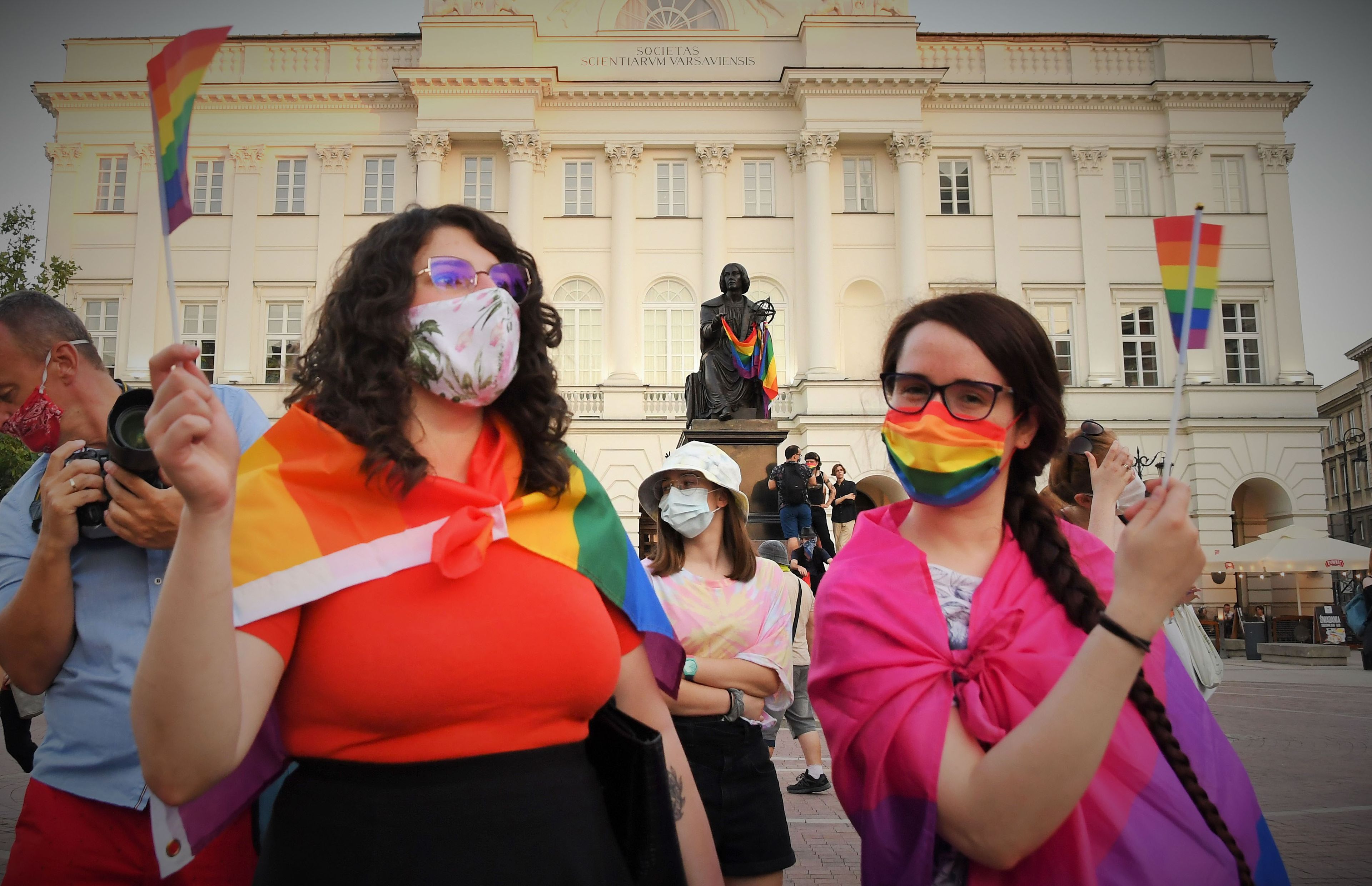Why are increasingly more young people declaring that they are LGBT+? [POLL]
Models of sexuality from fifty years ago do not pass the test today. In the United States, one in six Generation Z people identifies as LGBT+. Likewise, in Poland, young people are coming out in their masses. What do adults think of this? Is the right-wing narrative of the harmful fad winning out?
‘THIS IS an epidemic, a fad. It is the destruction of society,’ warned Jarosław Kaczyński, chairman of the Law and Justice (PiS) party, on 8 December at a meeting with voters in Chojnice. This is how, not for the first time, after all, he commented on the social phenomenon that has been surprising not only the right-wing populists in recent years. Young people and young adults are declaring that they are LGBT+ much more frequently than previous generations.
We asked what Poles thought about these changes in the latest Ipsos poll for OKO.press. The general result shows that more than one in three respondents (36%) agrees with the PiS chairman. However, the majority, 56%, believe the increasing number of people coming out is a result of increased social acceptance and less of a fear of discrimination.
Is it possible that one in six teenagers is LGBT+?
We do not have national statistics on which we can demonstrate precisely how these proportions are changing over time. In the United States, self-identification has been monitored by the Gallup Institute since 2012. By 2021, the proportion of people who say they are LGBT+ had increased from 3.5 to 5.6% of the total population.
However, among Generation Z, namely people born after 1997, the percentage of declarations is soaring, even as much as 15.9%.
This is more than the canonical assumptions of academics, who, based on their knowledge of human sexuality and gender identity, the scale of coming-out cases, and the grey, unspoken zone, estimated that around 10% of people in every society are probably non-heterosexual, while 1% are transgender people. In comparison, of today’s 30-year-olds, the percentage of LGBT people (according to their declarations) is 9.1%, whereas it is 3.8% among 40- and 50-year-olds.
Furthermore, it arises from the Trevor Project’s Survey on Mental Health in 2022 among 30,000 LGBT+ U.S. teens that, in addition to the scale itself, self-identification is also changing.
As many as 48% of respondents declared they are non-binary or transgender.
Among sexual orientations, pansexual or queer were chosen much more often than homosexual. They suggest an aversion to the rigid framework of the old identities (gay and lesbian), as well as a dissolution of social perception of gender (sexuality is increasingly frequently defined today despite someone’s gender/gender identity).
Although the fullest picture comes from the United States, this ‘trend’ has a global dimension, or is at least spilling over into most of Europe. Of course, local contexts cannot be forgotten. But, in a certain sense, America, distant but still culturally formative, has extreme tensions around the subject well.
On the one hand, the law there – unlike in Poland – recognizes same-sex marriages and protects LGBT people much more strongly against violence. On the other hand, the everyday life of the rainbow community there can be much more dramatic than in Poland.
Homelessness among LGBT+ teenagers, who have been rejected by their parents and local communities, is a true epidemic in the USA. Alongside Brazil and Mexico, the USA is the country with the highest recorded annual number of killings inspired by transphobia. Additionally, the slogan ‘Pray the gay away’ is breaking popularity records among the far right preying on religious communities that offer ‘healing’ from a life of Sodomy.
The survey results showing that half of U.S. LGBT+ teenagers aged 13–17 have had suicidal thoughts are most alarming. According to the Campaign Against Homophobia, this percentage is even higher in Poland, amounting to 70%.
Who understands the kids? Rather youths, women and residents of urban areas
Since age is of key importance for self-identification, it will also determine perceptions of social change.
According to the Ipsos poll, in the 18–29 age group, three out of four respondents believe that more rainbow coming-out cases are a consequence of increased acceptance. It is only in the 60+ group that more people can be found who believe it is not about any transformation of awareness, but a fad that has come to Poland – 38% and 49% of respondents respectively.
Women are more agreeable with the social changes. 63% of Polish women and just 48% of Polish men demonstrate a greater acceptance and lesser fear of discrimination. One in three women and almost half the men (44%) agree with Jarosław Kaczyński.
Also, the place of residence, which did not cause a disruption in other surveys on the perception of LGBT people and their rights, is particularly important in this case.
Rural areas struggle most with the wave of rainbow coming-out cases, with 45% of respondents indicating that this is a fad. Meanwhile, 46% of Polish rural inhabitants believe this is a consequence of increasing acceptance.
The largest cities are at the other extreme: here 20% of respondents sense a certain unnaturalness and temporariness of the situation. However, 70% are convinced that young LGBT+ people are simply no longer afraid.
Rocznik ‘92. Dziennikarz i reporter. Uhonorowany nagrodami: Amnesty International „Pióro Nadziei” (2018), Kampanii Przeciw Homofobii “Korony Równości” (2019). W OKO.press pisze o migracjach, społeczności LGBT+, edukacji, polityce mieszkaniowej i sprawiedliwości społecznej. Członek n-ost - międzynarodowej sieci dziennikarzy dokumentujących sytuację w Europie Środkowo-Wschodniej. Gdy nie pisze, robi zdjęcia. Początkujący fotograf dokumentalny i społeczny. Zainteresowany antropologią wizualną grup marginalizowanych oraz starymi technikami fotograficznymi.
Rocznik ‘92. Dziennikarz i reporter. Uhonorowany nagrodami: Amnesty International „Pióro Nadziei” (2018), Kampanii Przeciw Homofobii “Korony Równości” (2019). W OKO.press pisze o migracjach, społeczności LGBT+, edukacji, polityce mieszkaniowej i sprawiedliwości społecznej. Członek n-ost - międzynarodowej sieci dziennikarzy dokumentujących sytuację w Europie Środkowo-Wschodniej. Gdy nie pisze, robi zdjęcia. Początkujący fotograf dokumentalny i społeczny. Zainteresowany antropologią wizualną grup marginalizowanych oraz starymi technikami fotograficznymi.

Komentarze